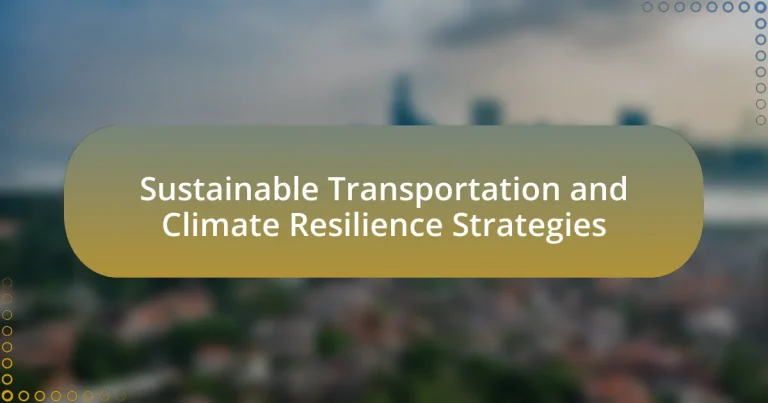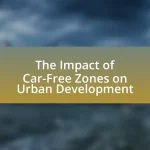Sustainable transportation encompasses eco-friendly transport methods that minimize environmental impact, such as public transit, cycling, walking, and electric vehicles, while climate resilience strategies focus on adapting transportation infrastructure to withstand climate change effects. The article explores how sustainable transportation contributes to climate resilience by reducing greenhouse gas emissions and enhancing infrastructure adaptability. Key principles include promoting energy efficiency, accessibility, and non-motorized transport, which collectively improve urban development and public health. Challenges in implementation, such as funding and technological barriers, are also addressed, alongside the importance of community engagement and effective metrics for evaluating success in sustainable transportation initiatives.
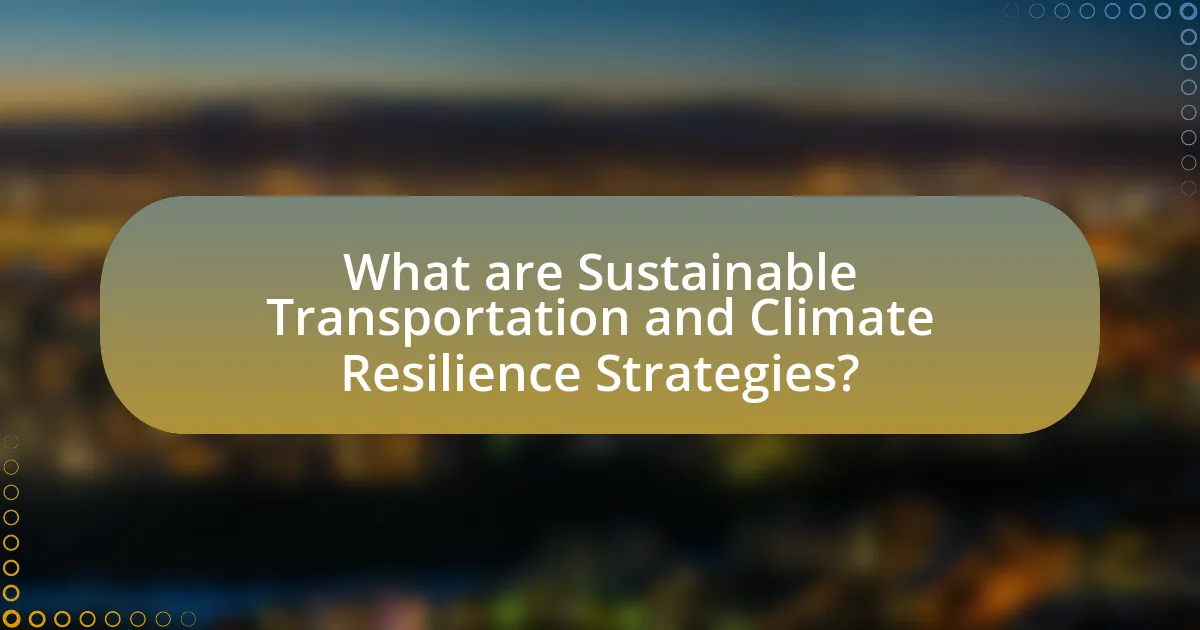
What are Sustainable Transportation and Climate Resilience Strategies?
Sustainable transportation refers to methods of transport that have a low impact on the environment, promoting energy efficiency and reducing greenhouse gas emissions. These strategies include the use of public transit, cycling, walking, and electric vehicles, which collectively aim to decrease reliance on fossil fuels and minimize air pollution. Climate resilience strategies, on the other hand, focus on adapting infrastructure and transportation systems to withstand the impacts of climate change, such as extreme weather events and rising sea levels. For instance, cities may implement green infrastructure, enhance public transit systems, and develop policies that encourage sustainable land use to improve resilience. Together, these strategies contribute to a more sustainable and adaptable transportation framework, essential for mitigating climate change effects and promoting environmental health.
How do Sustainable Transportation strategies contribute to climate resilience?
Sustainable transportation strategies enhance climate resilience by reducing greenhouse gas emissions and promoting adaptive infrastructure. These strategies, such as public transit expansion, cycling infrastructure, and electric vehicle adoption, lower reliance on fossil fuels, which mitigates climate change impacts. For instance, cities that invest in public transportation can reduce emissions by up to 45% compared to car-dependent urban areas. Additionally, sustainable transportation systems are designed to withstand climate-related disruptions, such as flooding or extreme weather, ensuring continued mobility and access. This dual benefit of emission reduction and infrastructure resilience supports communities in adapting to climate change while maintaining essential services.
What are the key principles of Sustainable Transportation?
The key principles of Sustainable Transportation include reducing greenhouse gas emissions, promoting energy efficiency, enhancing accessibility, and encouraging the use of public and non-motorized transport. These principles aim to create a transportation system that meets current mobility needs without compromising the ability of future generations to meet theirs. For instance, according to the Intergovernmental Panel on Climate Change, transitioning to low-emission transport modes can significantly lower carbon footprints and mitigate climate change impacts. Additionally, sustainable transportation emphasizes the importance of integrating land use and transportation planning to foster compact, walkable communities, which further supports environmental sustainability and social equity.
How do these principles enhance climate resilience?
The principles of sustainable transportation enhance climate resilience by promoting reduced greenhouse gas emissions and improving adaptive capacity. By prioritizing public transit, cycling, and walking, these principles decrease reliance on fossil fuels, which mitigates climate change impacts. For instance, cities that invest in sustainable transportation infrastructure, such as bike lanes and efficient public transit systems, have shown a significant reduction in carbon emissions, contributing to overall climate resilience. Additionally, sustainable transportation systems are designed to be more adaptable to climate-related disruptions, ensuring that communities can maintain mobility and access to essential services during extreme weather events. This adaptability is evidenced by studies indicating that cities with robust public transportation networks recover more quickly from climate-related disasters, thereby reinforcing their resilience.
Why is Sustainable Transportation important for urban development?
Sustainable transportation is crucial for urban development because it reduces greenhouse gas emissions and enhances the quality of life in cities. By promoting public transit, cycling, and walking, sustainable transportation minimizes traffic congestion and air pollution, leading to healthier urban environments. For instance, cities that invest in sustainable transport systems, like Copenhagen, have seen a 40% reduction in carbon emissions since 1995, demonstrating the effectiveness of such strategies in fostering climate resilience and sustainable urban growth.
What role does Sustainable Transportation play in reducing greenhouse gas emissions?
Sustainable transportation significantly reduces greenhouse gas emissions by promoting the use of low-emission vehicles, public transit, cycling, and walking. These modes of transport produce fewer emissions compared to traditional gasoline and diesel vehicles. For instance, a study by the International Council on Clean Transportation found that electric vehicles can reduce greenhouse gas emissions by up to 70% compared to conventional vehicles over their lifetime. Additionally, increasing public transit usage can lead to a reduction of approximately 45 million metric tons of carbon dioxide annually in the United States alone, as reported by the American Public Transportation Association. Therefore, sustainable transportation is crucial in mitigating climate change impacts through substantial reductions in greenhouse gas emissions.
How can Sustainable Transportation improve public health and safety?
Sustainable transportation improves public health and safety by reducing air pollution and promoting active modes of travel, such as walking and cycling. Lower emissions from vehicles lead to better air quality, which is linked to decreased respiratory and cardiovascular diseases. For instance, a study published in the journal Environmental Health Perspectives found that reducing vehicle emissions could prevent thousands of premature deaths annually. Additionally, infrastructure that supports walking and cycling encourages physical activity, which is associated with lower obesity rates and improved mental health. According to the World Health Organization, increased physical activity can reduce the risk of chronic diseases, further enhancing public health outcomes.
What challenges do cities face in implementing Sustainable Transportation?
Cities face significant challenges in implementing sustainable transportation, primarily due to funding limitations, infrastructure inadequacies, and public resistance. Funding constraints often hinder the development of necessary projects, as cities struggle to allocate resources amidst competing budgetary demands. Infrastructure inadequacies, such as insufficient public transit systems and lack of bike lanes, impede the transition to more sustainable modes of transport. Additionally, public resistance can arise from a lack of awareness or perceived inconvenience associated with changes to transportation systems. According to a report by the Institute for Transportation and Development Policy, cities that have successfully implemented sustainable transportation initiatives often require substantial investment and community engagement to overcome these barriers.
How do funding and policy affect the adoption of Sustainable Transportation?
Funding and policy significantly influence the adoption of sustainable transportation by providing the necessary financial resources and regulatory frameworks that encourage investment in eco-friendly transport solutions. For instance, government subsidies for electric vehicles and public transit systems can lower the cost barrier for consumers and businesses, leading to increased adoption rates. Additionally, policies that mandate emissions reductions or set targets for renewable energy use in transportation create a structured environment that incentivizes innovation and compliance. Research from the International Energy Agency indicates that countries with robust funding mechanisms and supportive policies, such as the European Union’s Green Deal, have seen a marked increase in the deployment of sustainable transport technologies, demonstrating the direct correlation between financial support, regulatory measures, and the successful implementation of sustainable transportation initiatives.
What are the technological barriers to Sustainable Transportation?
Technological barriers to sustainable transportation include limitations in battery technology, insufficient charging infrastructure, and high costs of renewable energy systems. Battery technology, particularly for electric vehicles, often lacks the energy density and charging speed required for widespread adoption, as evidenced by the fact that current lithium-ion batteries can take hours to charge fully. Insufficient charging infrastructure further hampers the transition, with studies indicating that a robust network of charging stations is essential for consumer confidence and convenience. Additionally, the high costs associated with developing and implementing renewable energy systems, such as solar or wind power, can deter investment in sustainable transportation solutions. These barriers collectively hinder the advancement and adoption of sustainable transportation technologies.
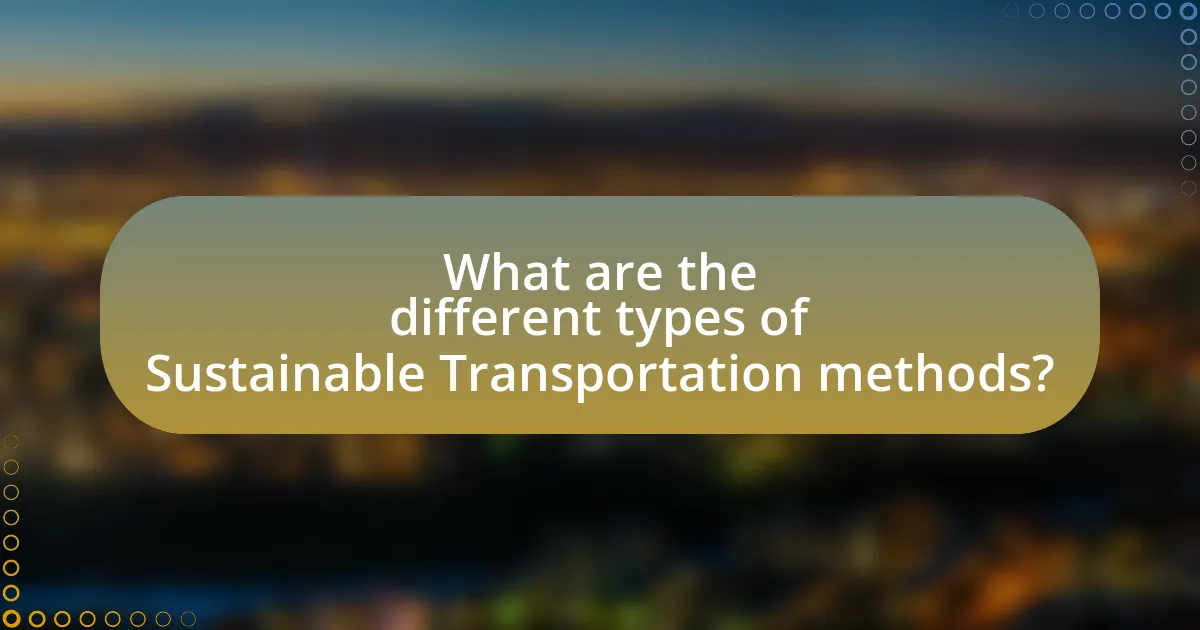
What are the different types of Sustainable Transportation methods?
Sustainable transportation methods include public transit, cycling, walking, carpooling, electric vehicles, and alternative fuels. Public transit reduces individual car use, thereby lowering greenhouse gas emissions; for instance, buses can carry multiple passengers, significantly decreasing per capita emissions. Cycling and walking promote health and reduce reliance on fossil fuels, with cities like Amsterdam showcasing high cycling rates and associated environmental benefits. Carpooling optimizes vehicle use, further minimizing emissions. Electric vehicles, powered by renewable energy sources, contribute to reduced air pollution; in 2020, electric vehicles accounted for 4.2% of global car sales, indicating a growing trend. Alternative fuels, such as biofuels and hydrogen, offer additional sustainable options, with research showing that biofuels can reduce lifecycle greenhouse gas emissions by up to 80% compared to conventional fuels.
How do public transit systems contribute to Sustainable Transportation?
Public transit systems contribute to sustainable transportation by reducing the number of individual vehicles on the road, which decreases greenhouse gas emissions and traffic congestion. For instance, a study by the American Public Transportation Association found that public transit saves approximately 45 million metric tons of carbon dioxide annually, equivalent to the emissions from 9 million cars. Additionally, public transit promotes energy efficiency, as buses and trains can transport many passengers simultaneously, leading to lower per capita energy consumption compared to private vehicles. This efficiency is further supported by the fact that public transit systems often utilize cleaner energy sources, such as electricity or biofuels, enhancing their sustainability profile.
What are the benefits of investing in public transit infrastructure?
Investing in public transit infrastructure enhances urban mobility, reduces traffic congestion, and lowers greenhouse gas emissions. Improved public transit systems provide efficient transportation options, which can lead to a decrease in the number of private vehicles on the road. For instance, a study by the American Public Transportation Association found that public transit saves approximately 45 million metric tons of carbon dioxide annually, contributing to climate resilience. Additionally, robust public transit networks can stimulate local economies by creating jobs and increasing access to employment opportunities, as evidenced by the $4 in economic returns for every $1 invested in public transit infrastructure.
How can cities improve public transit accessibility?
Cities can improve public transit accessibility by implementing universal design principles, enhancing infrastructure, and increasing service frequency. Universal design ensures that transit systems accommodate all users, including those with disabilities, by incorporating features like low-floor buses and accessible stations. Enhancing infrastructure involves creating dedicated bus lanes and improving the condition of sidewalks and crosswalks, which facilitates easier access to transit stops. Increasing service frequency reduces wait times and makes public transit a more viable option for commuters. According to the American Public Transportation Association, cities that invest in these strategies see a significant increase in ridership and overall satisfaction among users.
What role do non-motorized transportation options play?
Non-motorized transportation options play a crucial role in promoting sustainable transportation and enhancing climate resilience. These options, which include walking, cycling, and the use of scooters, significantly reduce greenhouse gas emissions and reliance on fossil fuels. For instance, a study by the Institute for Transportation and Development Policy found that increasing cycling and walking can reduce urban carbon emissions by up to 30%. Additionally, non-motorized transportation improves public health by encouraging physical activity and reducing air pollution, which is linked to respiratory diseases. Furthermore, these modes of transport contribute to more resilient urban infrastructure by decreasing traffic congestion and enhancing accessibility, thereby fostering more livable communities.
How can cycling and walking infrastructure be enhanced?
Cycling and walking infrastructure can be enhanced by implementing dedicated bike lanes, improving pedestrian pathways, and increasing connectivity between different modes of transport. Dedicated bike lanes reduce conflicts between cyclists and motor vehicles, leading to safer riding conditions; cities like Copenhagen have seen a 62% increase in cycling due to such infrastructure improvements. Improving pedestrian pathways, including wider sidewalks and better crosswalks, enhances safety and accessibility, as evidenced by studies showing that wider sidewalks can increase foot traffic by up to 40%. Additionally, increasing connectivity through bike-sharing programs and pedestrian-friendly urban designs fosters a seamless transition between cycling, walking, and public transport, promoting sustainable transportation options and reducing reliance on cars.
What are the environmental benefits of promoting non-motorized transport?
Promoting non-motorized transport significantly reduces greenhouse gas emissions, contributing to improved air quality and lower urban heat levels. Non-motorized transport, such as walking and cycling, generates no emissions during use, which directly decreases the reliance on fossil fuels and mitigates climate change. According to the European Environment Agency, transportation accounts for about 25% of total greenhouse gas emissions in the EU, with road transport being a major contributor. By increasing the share of non-motorized transport, cities can lower their carbon footprints and enhance public health through reduced pollution levels. Additionally, non-motorized transport promotes green spaces and biodiversity, as less land is needed for roads and parking, allowing for more vegetation and wildlife habitats.
How do electric and alternative fuel vehicles fit into Sustainable Transportation?
Electric and alternative fuel vehicles are integral to sustainable transportation as they significantly reduce greenhouse gas emissions and reliance on fossil fuels. These vehicles, such as electric cars and hydrogen fuel cell vehicles, operate on energy sources that are cleaner and more sustainable compared to traditional gasoline or diesel engines. For instance, according to the U.S. Environmental Protection Agency, electric vehicles produce zero tailpipe emissions, which contributes to improved air quality and lower overall carbon footprints. Furthermore, the adoption of alternative fuels, like biofuels and electricity from renewable sources, supports the transition to a more sustainable energy system, aligning with global climate goals and enhancing energy security.
What are the advantages of electric vehicles over traditional vehicles?
Electric vehicles (EVs) offer several advantages over traditional vehicles, primarily in terms of environmental impact, operational costs, and performance. EVs produce zero tailpipe emissions, significantly reducing air pollution and greenhouse gas emissions compared to gasoline or diesel vehicles, which contribute to climate change and health issues. According to the U.S. Environmental Protection Agency, transportation is responsible for nearly 29% of total greenhouse gas emissions in the United States, highlighting the importance of transitioning to cleaner alternatives like EVs.
Additionally, EVs typically have lower operating costs due to reduced fuel expenses and less maintenance. The U.S. Department of Energy states that electricity is generally cheaper than gasoline on a per-mile basis, and EVs have fewer moving parts, leading to lower maintenance costs over time. Furthermore, EVs often provide superior acceleration and a quieter driving experience, enhancing overall performance and user satisfaction.
These advantages position electric vehicles as a crucial component of sustainable transportation and climate resilience strategies.
How can alternative fuels contribute to reducing emissions?
Alternative fuels can significantly reduce emissions by replacing conventional fossil fuels with cleaner energy sources. For instance, biofuels, hydrogen, and electricity from renewable sources emit lower levels of greenhouse gases compared to gasoline and diesel. According to the U.S. Department of Energy, using biofuels can reduce lifecycle greenhouse gas emissions by up to 86% compared to traditional fuels. Additionally, electric vehicles powered by renewable energy sources can eliminate tailpipe emissions entirely, contributing to improved air quality and reduced carbon footprints.
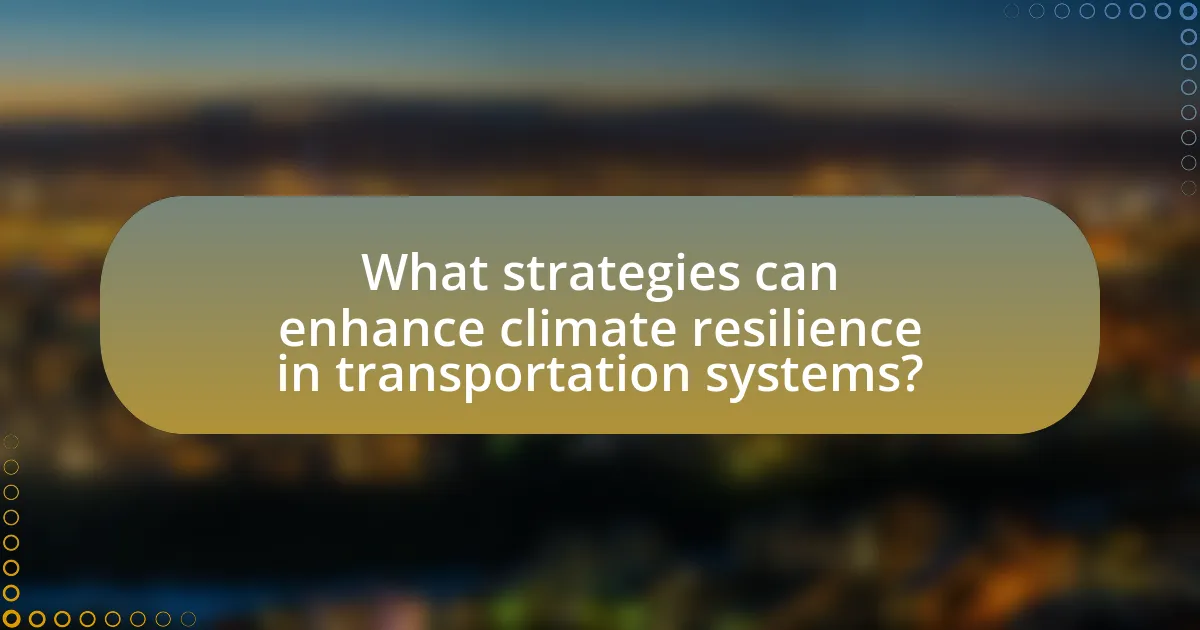
What strategies can enhance climate resilience in transportation systems?
Strategies that can enhance climate resilience in transportation systems include the integration of climate risk assessments, the adoption of adaptive infrastructure designs, and the implementation of sustainable materials. Climate risk assessments allow transportation planners to identify vulnerabilities and prioritize investments in areas most at risk from climate impacts, such as flooding or extreme weather events. Adaptive infrastructure designs, such as elevating roadways and using permeable materials, can mitigate damage from climate-related disruptions. Additionally, utilizing sustainable materials reduces the carbon footprint of transportation projects and enhances long-term durability. These strategies are supported by studies indicating that proactive planning and investment in resilient infrastructure can significantly reduce the economic and social costs associated with climate impacts on transportation systems.
How can cities integrate climate adaptation into transportation planning?
Cities can integrate climate adaptation into transportation planning by incorporating climate risk assessments into their infrastructure projects. This involves evaluating potential climate impacts, such as flooding or extreme heat, on transportation systems and designing resilient infrastructure that can withstand these challenges. For instance, cities like New York have implemented green infrastructure solutions, such as permeable pavements and enhanced drainage systems, to mitigate flooding risks. Additionally, transportation planning can include the development of flexible transit options that adapt to changing climate conditions, ensuring continued accessibility and mobility. Evidence from the National Oceanic and Atmospheric Administration indicates that proactive adaptation measures can significantly reduce long-term costs associated with climate-related disruptions in transportation networks.
What are the best practices for assessing climate risks in transportation?
The best practices for assessing climate risks in transportation include conducting vulnerability assessments, integrating climate data into planning processes, and engaging stakeholders throughout the assessment. Vulnerability assessments identify critical infrastructure and potential climate impacts, such as flooding or extreme weather events, which can disrupt transportation systems. Integrating climate data, such as projections for sea-level rise or temperature changes, into transportation planning ensures that future projects are resilient to climate impacts. Engaging stakeholders, including local communities and transportation agencies, fosters collaboration and ensures that diverse perspectives are considered, enhancing the robustness of the assessment. These practices are supported by frameworks like the Federal Highway Administration’s Climate Change and Extreme Weather Vulnerability Assessment Framework, which provides guidelines for effective risk assessment in transportation.
How can infrastructure be designed to withstand climate impacts?
Infrastructure can be designed to withstand climate impacts by incorporating resilient materials, adaptive designs, and strategic planning. Resilient materials, such as high-performance concrete and weather-resistant coatings, enhance durability against extreme weather events. Adaptive designs, including elevated structures and flexible layouts, allow infrastructure to respond to changing environmental conditions. Strategic planning involves assessing climate risks through data analysis and integrating green infrastructure, such as permeable pavements and green roofs, to manage stormwater and reduce urban heat. These approaches are supported by studies indicating that resilient infrastructure can reduce repair costs by up to 50% during climate-related disasters, demonstrating their effectiveness in mitigating climate impacts.
What role does community engagement play in developing climate-resilient transportation?
Community engagement is crucial in developing climate-resilient transportation as it ensures that the needs and perspectives of local populations are incorporated into planning and decision-making processes. Engaging communities allows for the identification of specific vulnerabilities and priorities related to transportation infrastructure, which can lead to more effective and tailored solutions. For instance, studies have shown that when communities participate in transportation planning, projects are more likely to address local climate risks, such as flooding or extreme weather events, thereby enhancing resilience. Furthermore, community input can foster greater public support and collaboration, which are essential for the successful implementation of sustainable transportation initiatives.
How can public participation improve transportation planning outcomes?
Public participation can significantly improve transportation planning outcomes by ensuring that the needs and preferences of the community are accurately reflected in the planning process. Engaging the public allows for the identification of local issues, preferences, and priorities that may not be evident to planners. For instance, studies have shown that projects with strong public involvement tend to have higher rates of acceptance and usage, as they are more aligned with community needs. A report by the American Planning Association highlights that inclusive planning processes lead to better decision-making and more effective allocation of resources, ultimately resulting in transportation systems that are more efficient and equitable.
What strategies can be used to educate communities about Sustainable Transportation?
Effective strategies to educate communities about Sustainable Transportation include community workshops, informational campaigns, and partnerships with local organizations. Community workshops provide hands-on learning experiences, allowing participants to engage directly with sustainable practices, such as cycling and public transit use. Informational campaigns, utilizing social media and local media outlets, can disseminate key messages about the benefits of sustainable transportation, such as reduced emissions and improved public health. Partnerships with local organizations, including schools and environmental groups, can enhance outreach efforts and foster a collaborative approach to education. Research indicates that community engagement significantly increases awareness and adoption of sustainable practices, as seen in studies conducted by the National Center for Sustainable Transportation, which highlight the effectiveness of localized education initiatives in promoting sustainable behaviors.
What are the key indicators of success for Sustainable Transportation and climate resilience strategies?
Key indicators of success for Sustainable Transportation and climate resilience strategies include reduced greenhouse gas emissions, increased use of public transportation, and improved air quality. These indicators demonstrate the effectiveness of strategies aimed at minimizing environmental impact and enhancing community resilience. For instance, cities that have implemented comprehensive public transit systems often report a significant decrease in per capita emissions; for example, a study by the American Public Transportation Association found that public transit saves 45 million metric tons of carbon dioxide annually. Additionally, improvements in air quality can be measured through lower levels of pollutants such as nitrogen dioxide and particulate matter, which are directly linked to transportation emissions. These metrics collectively provide a clear framework for assessing the success of sustainable transportation initiatives and their contribution to climate resilience.
How can cities measure the effectiveness of their Sustainable Transportation initiatives?
Cities can measure the effectiveness of their Sustainable Transportation initiatives through various metrics such as reductions in greenhouse gas emissions, increases in public transit ridership, and improvements in air quality. For instance, cities can track the percentage decrease in carbon emissions by comparing data before and after implementing initiatives like bike-sharing programs or electric bus fleets. Additionally, surveys can assess changes in public transit usage, revealing shifts in commuter behavior. Air quality monitoring stations can provide concrete data on pollution levels, demonstrating the environmental impact of these initiatives. By analyzing these metrics, cities can evaluate the success and areas for improvement in their sustainable transportation efforts.
What metrics are essential for evaluating climate resilience in transportation?
Essential metrics for evaluating climate resilience in transportation include infrastructure vulnerability assessments, service reliability metrics, and adaptive capacity indicators. Infrastructure vulnerability assessments measure the susceptibility of transportation systems to climate-related hazards, such as flooding or extreme weather events. Service reliability metrics evaluate the consistency and dependability of transportation services under varying climate conditions, often using data on delays and disruptions. Adaptive capacity indicators assess the ability of transportation systems to adjust and respond to climate impacts, which can include the implementation of new technologies or policies. These metrics collectively provide a comprehensive framework for understanding and enhancing the resilience of transportation systems in the face of climate change.
What practical steps can communities take to promote Sustainable Transportation?
Communities can promote sustainable transportation by implementing comprehensive public transit systems, enhancing cycling infrastructure, and encouraging carpooling initiatives. A well-developed public transit system reduces reliance on personal vehicles, as evidenced by cities like Portland, Oregon, where increased public transit usage has led to a 20% reduction in greenhouse gas emissions since 1990. Additionally, investing in safe and accessible cycling paths encourages more residents to choose biking over driving; for instance, Amsterdam’s extensive cycling network has resulted in over 60% of its residents using bicycles for daily commutes. Lastly, carpooling programs, such as those facilitated by local governments in California, have been shown to decrease traffic congestion and lower individual carbon footprints by promoting shared rides.
